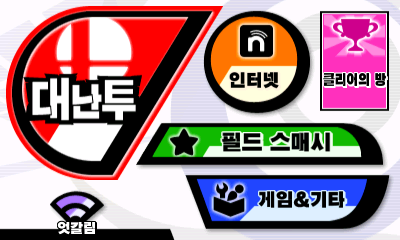Super Smash Bros. for Nintendo 3DS/Version Differences
This is a sub-page of Super Smash Bros. for Nintendo 3DS.
Contents
- 1 Regional Differences
- 2 Revisional Differences
Regional Differences
Character Names
Some of the characters have a different name depending on the version.
| English | Japanese | German | French | Spanish (Spain) | Spanish (Latin America) | Portuguese | Italian | Dutch |
|---|---|---|---|---|---|---|---|---|
| Bowser | Koopa | Bowser | Bowser | Bowser | Bowser | Bowser | Bowser | Bowser |
| Bowser Jr. | Koopa Jr. | Bowser Jr. | Bowser Jr. | Bowsy | Bowser Jr. | Bowser Jr. | Bowser Junior | Bowser Jr. |
| Captain Falcon | Captain Falcon | Captain Falcon | Captain Falcon | Captain Falcon | Capitán Falcon | Captain Falcon | Captain Falcon | Captain Falcon |
| Charizard | Lizardon | Glurak | Dracaufeu | Charizard | Charizard | Charizard | Charizard | Charizard |
| Dark Pit | Black Pit | Finsterer Pit | Pit Maléfique | Pit Sombrío | Pit Sombrío | Pit Sombrio | Pit Oscuro | Dark Pit |
| Duck Hunt | Duckhunt | Duck Hunt Duo | Duo Duck Hunt | Dúo Duck Hunt | Duck Hunt | Duo Duck Hunt | Duo Duck Hunt | Duck Hunt-Duo |
| Greninja | Gekkouga | Quajutsu | Amphinobi | Greninja | Greninja | Greninja | Greninja | Greninja |
| Jigglypuff | Purin | Pummeluff | Rondoudou | Jigglypuff | Jigglypuff | Jigglypuff | Jigglypuff | Jigglypuff |
| King Dedede | Dedede | König Dedede | Roi Dadidou | Rey Dedede | Rey Dedede | King Dedede | King Dedede | King Dedede |
| Mega Man | Rockman | Mega Man | Mega Man | Mega Man | Mega Man | Mega Man | Mega Man | Mega Man |
| R.O.B. | Robot | R.O.B. | R.O.B. | R.O.B. | R.O.B. | R.O.B. | R.O.B. | R.O.B. |
| Robin | Reflet | Daraen | Daraen | Daraen | Robin | Robin | Daraen | Robin |
| Rosalina & Luma | Rosetta & Chiko | Rosalina & Luma | Harmonie & Luma | Estela y Destello | Rosalina y Destello | Rosalina e Luma | Rosalinda e Sfavillotto | Rosalina en Luma |
| Sheik | Sheik | Shiek | Sheik | Sheik | Sheik | Sheik | Sheik | Sheik |
| Toon Link | Toon Link | Toon Link | Link Cartoon | Toon Link | Toon Link | Link Cartoon | Link Cartone | Toon Link |
| Villager | Murabito | Bewohner/Bewohnerin | Villageois/Villageoise | Aldeano/Aldeana | Aldeano/Aldeana | Habitante | Abitante | Dorpsbewoner |
| Wii Fit Trainer | Wii Fit Trainer | Wii Fit-Trainerin | Entraîneuse Wii Fit/Entraîneur Wii Fit | Entrenadora de Wii Fit/Entrenador de Wii Fit | Entrenadora de Wii Fit/Entrenador de Wii Fit | Instrutora do Wii Fit/Instrutor do Wii Fit | Trainer di Wii Fit | Wii Fit Trainer |
| Zero Suit Samus | Zero Suit Samus | Zero Suit Samus | Samus Sans Armure | Samus Zero | Samus Zero | Samus (Armadura Zero) | Samus Tuta Zero | Zero Suit Samus |
- The character "Duck Hunt" is renamed as "Duck Hunt Duo" in European releases.
- In Japanese language, the announcer pronounces Lucina with a hard C instead of a soft C.
- Olimar and Alph are referred to as "Pikmin & Olimar/Alph" in the Japanese versions, but drop the Pikmin from their names elsewhere. The official site still has the Pikmin in their names in all languages.
- The Spanish announcer (the Latin America version) pronounces Pikachu "peekuh-choo", accentuating the "chu" syllable.
R.O.B.
| Japan | US |
|---|---|
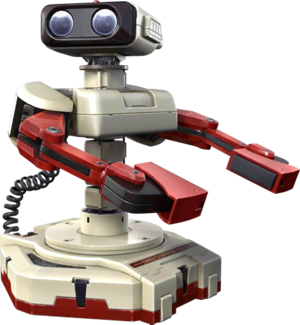 |
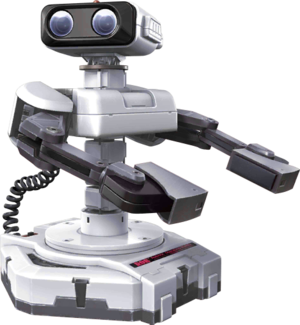 |
Like his appearance in Mario Kart DS, R.O.B.'s default color scheme changes based on the region of the game: his Famicom colors in Japan, and his NES colors in North America. In Brawl, his Famicom palette was the default in all regions.
| Japan | US |
|---|---|
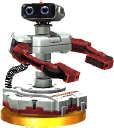 |
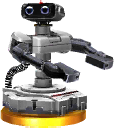 |
His Trophies and costume orders have also been changed accordingly. Other icons, such as his Sound Test icon, remain unchanged.
| Japan | US |
|---|---|
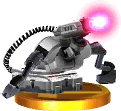 |
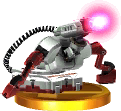 |
Since his All-Star Trophy is meant to represent an alternate color scheme, the two regions have their colors reversed.
| Japan | US |
|---|---|
Additionally, his name differs between the two versions: "Robot" in Japan, "R.O.B." in North America.
Stat distribution titles
| To do: Check the titles in the US and Japanese versions of the game, and transcribe the Russian titles. |
When choosing your equipment, a subtitle appears under your stat distribution pie chart. For most of the European languages, this title is short of interesting, just a word explaining bluntly what the loadout is mostly about. But the Portuguese and Spanish languages actually give these titles interesting names!
| English | German | French | Italian | Dutch | Portuguese | Spanish | |
|---|---|---|---|---|---|---|---|
| Mostly balanced | Balanced | Ausgeglichen | Équilibré | Bilanciato | Allround | Balançado | Equilibrado |
| Mostly attack | Attacker | Angreifer | Offensif | Attaccante | Aanval | Bárbaro (Barbarian) | Guerrero (Warrior) |
| Mostly defense | Defender | Verteidiger | Défensif | Difensore | Defensie | Legionário (Legionary) | Defensor |
| Mostly speed | Speedster | Sprinter | Rapide | Velocista | Snelheid | Batedor (Batter) | Velocista |
| Mostly attack and defense | Atk/Def | Ang./Abw. | Offensif/Défensif | Attaccante/Difensore | Aanv. + Def. | Paladino (Paladin) | Paladín (Paladin) |
| Mostly attack and speed | Spd/Atk | Tmp./Ang. | Rapide/Offensif | Velocista/Attaccante | Snelh. + Aanv. | Ninja | Temerario (Daredevil) |
| Mostly defense and speed | Def/Spd | Abw./Tmp. | Défensif/Rapide | Difensore/Velocista | Def. + Snelh. | Samurai | Protector |
Untranslated titles either mean the same thing as the English title, or are self-explanatory.
Miscellaneous Differences
In addition to the usual localization changes to accommodate games and characters receiving different names in different regions, a few other differences can be spotted:
- Any cases of lowercase letters in the character's Touch Screen eyecatches have been removed, with the exception of the Wii Fit Trainer.
- Both the male and female Wii Fit Trainers have British voice actors in UK releases of the game, likely to fit in with the way the Wii Fit games were localized. Other European countries also adapt this change, although obviously with their own respective languages.
- The character "Duck Hunt" is renamed as "Duck Hunt Duo" in European releases.
- In the Sound Test Voices section, Rosalina & Luma's voices/sounds are under Rosalina's name, despite Luma's voice actor being present in those voice clips.
| Japan | US |
|---|---|
As in Brawl, Dedede's "king" moniker is only present in localized versions, due to how Dedede's title in Japanese is very clearly a self-appointed one, something very difficult to replicate in English. The pronunciation of his name is also altered to make more sense overseas.
| Japan | US |
|---|---|
| Japan | US |
|---|---|
Olimar and Alph are referred to as "Pikmin & Olimar/Alph" in the Japanese versions, but drop the Pikmin from their names elsewhere.
| Japan | US |
|---|---|
Lucina's name is pronounced differently between Japanese and international releases, using a hard C for the former and a soft C for the latter.
- Trophy descriptions display significant differences on the whole, even between different English releases.
- Kirby has different voice clips when he copies Palutena and Shulk's neutral special moves to accommodate for the new translations, a rarity in the series as they usually go untranslated. However, his voice for Jigglypuff goes untranslated yet again.
- Just like in previous games, metric units are changed to imperial units in the North American version. Since all internal data remains in metric, several challenges have unusual-looking requirements, such as "Hit Sandbag 3280 feet" (1000m). Incidentally, beating this particular challenge provides the player with a message of "Achieved a score of 1000 in Home-Run Contest", which was probably missed because it lacks the "m".
- Ashley's Song uses the Japanese vocals in its version, and the English vocals internationally. This contrasts with the Wii U version and Brawl, which included both versions of the song regardless of region. However, an international release can hear the Japanese vocals if a replay on the Replay Channel is playing Ashley's Song on the WarioWare stage with Player 1 having a Japanese game. The reverse is likely, though unproven, to occur. This is relatively hard to experience due to the specifics of how to make it work.
Korean Differences
The Korean version removed the main menu option to connect to Wii U, because the Wii U version (as well as the console itself) was not released in South Korea.
The button is also hidden in non-Korean versions of the game when played under Korean region settings, which is not normally possible. The opposite will happen when playing the Korean version with non-Korean region settings.
Revisional Differences
Version 1.0.1
A patch released on launch day in Japan. While players who buy a physical copy must manually download the update, the downloadable version comes with the update preinstalled. The update adds online functionality as well as a "Conquest" feature which launched on September 15, 2014.
Version 1.0.2
Another patch was released on September 18, 2014 in Japan and was made available internationally upon the game's release. This patch addresses issues with Peach's turnip-throwing Down Special causing bans in the no-items For Glory online mode. It also addresses other minor issues that have not been specified.
Version 1.0.3
This patch was released worldwide on October 27, 2014. Conquest mode will no longer display the current results of the Conquest in progress. The update includes a slightly different mix of the Battle! Reshiram / Zekrom song for the N's Castle stage as well. It also addresses other minor issues that have not been specified.
Version 1.0.4
This patch was released on November 18, 2014. It further balances the game with character changes, the reintroduction of the directional influence gameplay mechanic from Melee and Brawl, and the removal of the DACUS technique left over from Brawl in previous versions. This update also disables replays made in all previous versions.
The patch also fixes a bug that was present in all previous versions: if the player used Yoshi in Multi-Man Smash and continuously used Egg Lay on giant non-Mii opponents, the enemies would become larger and larger each time until they filled the entire screen.
Version 1.0.5
This patch was released on February 9, 2015. This version finally implements online data sharing between players, and adds Amiibo support for the New 3DS. Amiibo-related Tips were added as part of this. Posting screenshots to Miiverse with the original 3DS is also possible with this update.
Version 1.0.6
This patch was made available on the eShop on April 15, 2015. This version implements an in-game store section accessible via the Main Menu for purchasing DLC. It also makes several adjustments to the characters in order to balance gameplay (full list of confirmed changes here). Replay data created in previous versions will no longer be viewable. This patch is required in order to play online and locally.
Mewtwo DLC
The Mewtwo DLC not only adds the character as a fighter and as an opponent in the various game modes, but also adds two trophies that cannot be obtained without the DLC: a new Mewtwo trophy (which has exactly the same name and does not take the place of the old one), and a Mewtwo (Alt.) trophy. The DLC also adds Mewtwo-related Tips.
Version 1.0.7
This patch was released on April 24, 2015, and addresses a bug that causes a player's Global Smash Power ranking to become corrupted after playing as Mewtwo in certain game modes, preventing them from playing online. It also fixes a glitch involving exploiting garbage data in the form of Mewtwo's "custom moves", which it does not actually have.
Version 1.0.8
This patch was released on June 14, 2015 and adds compatibility with the Nintendo 3DS NFC Reader/Writer accessory (to be released later) and more downloadable content. Dream Land (64) from the original Super Smash Bros., three additional characters, an Inkling trophy, and several Mii Fighter costumes are included in the downloadable content. This patch once again disables replays from previous versions.
Lucas DLC
The Lucas DLC not only adds the character as a fighter and as an opponent in the various game modes, but also adds two trophies that cannot be obtained without the DLC: a new Lucas trophy (which has exactly the same name and does not take the place of the old one), and a Lucas (Alt.) trophy. The DLC also adds Lucas-related Tips.
Roy DLC
The Roy DLC not only adds the character as a fighter and as an opponent in the various game modes, but also adds two trophies that cannot be obtained without the DLC: a Roy trophy and a Roy (Alt.) trophy. The DLC also adds Roy-related Tips.
Ryu DLC
The Ryu DLC not only adds the character as a fighter and as an opponent in the various game modes, but also adds three trophies that cannot be obtained without the DLC: a Ryu trophy, a Ryu (Alt.) trophy, and a Ken trophy. The DLC also adds the Suzaku Castle stage and Ryu-related Tips.
Version 1.1.0
This patch was released on July 31, 2015. More downloadable content is released in the form of Mii Fighter costumes and two stages from the original Super Smash Bros.: Hyrule Castle and Peach's Castle. The K.K. Slider hat and outfit are also added to the Mii Fighter customization for free. Minor adjustments to various characters are also made, full list of confirmed changes here.
Version 1.1.1
This patch was released on September 30, 2015. More downloadable content is released in the form of Mii Fighter costumes and a new stage based on Super Mario Maker. The Duck Hunt stage from the Wii U version is also added to the stage selection for free. Adjustments to various characters were also made, full list of confirmed changes here.
Version 1.1.2
This patch was released on October 8, 2015. A glitch involving Diddy Kong becoming invulnerable to grabs is fixed.
Version 1.1.3
This patch was released on December 15, 2015. and adds one new character (Cloud) and two Mii Fighter costumes (a Chocobo Hat and a Geno Mii Gunner costume) as downloadable content. The character selection screen is updated to accommodate all of the DLC characters, moving them to a separate "Extra Fighters" screen.
Cloud DLC
The Cloud DLC not only adds the character as a fighter and as an opponent in the various game modes, but also adds two trophies that cannot be obtained without the DLC: a Cloud trophy and a Cloud (Alt.) trophy. The DLC also adds the Midgar stage and Cloud-related Tips.
Version 1.1.4
This patch was released on February 3, 2016, and adds several new Trophies. Two new characters and more Mii Fighter costumed are also released as the final set of downloadable content. More character adjustments were made as well. A full list of confirmed changes can be found here.
Corrin DLC
The Corrin DLC not only adds the character as a fighter and as an opponent in the various game modes, but also adds two trophies that cannot be obtained without the DLC: a Corrin trophy and a Corrin (Alt.) trophy. The DLC also adds the theme of Fire Emblem Fates, "Lost In Thoughts All Alone", and a remix of the theme to the Sound Test (and by extension the song selection for Smash Run), and also includes Corrin-related Tips.
Bayonetta DLC
The Bayonetta DLC not only adds the character as a fighter and as an opponent in the various game modes, but also adds two trophies that cannot be obtained without the DLC: a Bayonetta trophy and a Bayonetta (Alt.) trophy. The DLC also adds the Umbra Clock Tower stage, and also includes Bayonetta-related Tips.
Version 1.1.5
This patch was made available on March 15, 2016, and makes more adjustments to characters in order to balance gameplay. A full list of confirmed changes can be found here.
Version 1.1.6
This patch was released on May 20, 2016. The only notable change made in the patch was to reduce Bayonetta's overall fighting ability. A full list of confirmed changes can be found here.
Version 1.1.7
This patch was released on July 18, 2017. This patch adds support for Cloud, Corrin, and Bayonetta amiibo.
